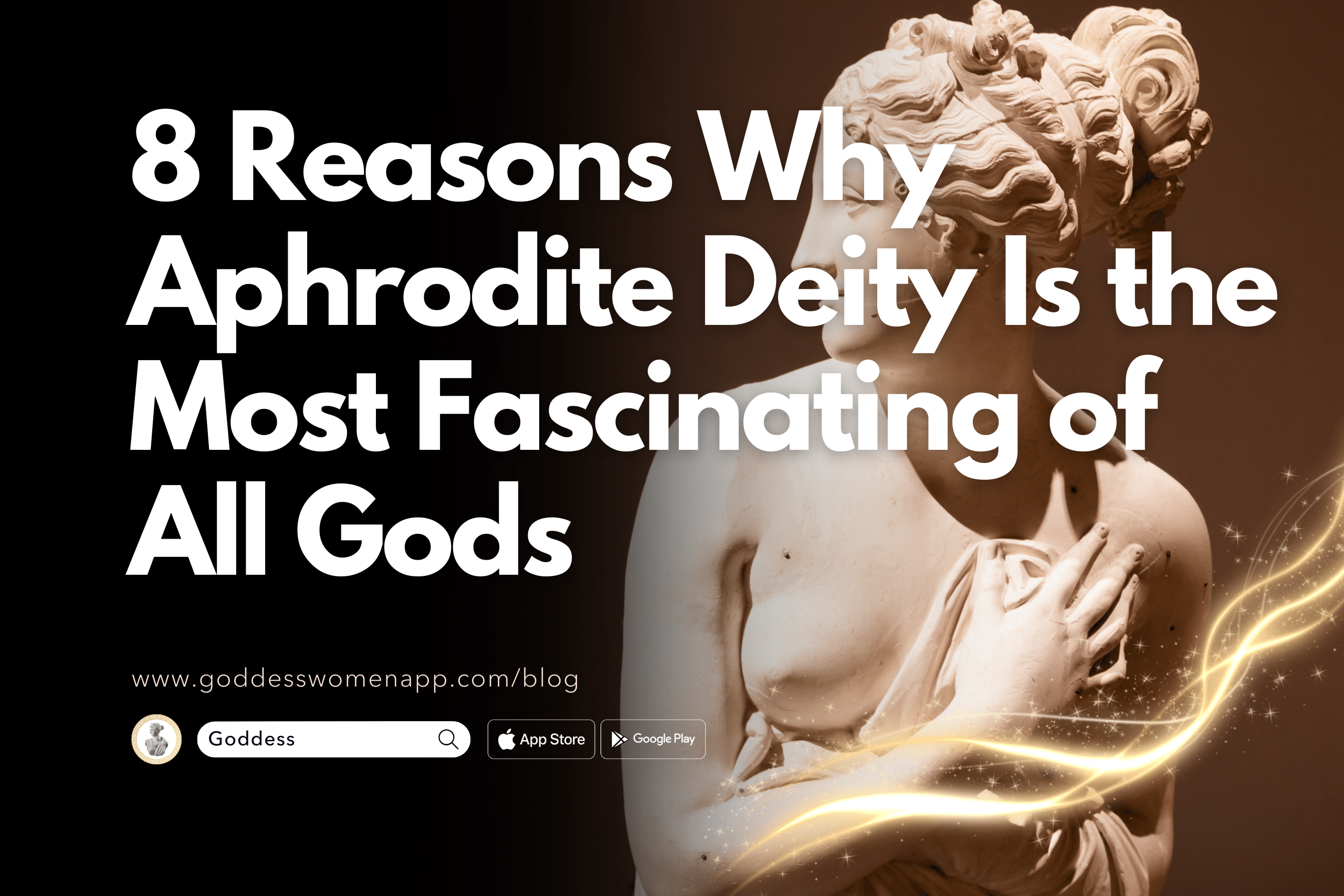Table of Contents
Introduction
In the pantheon of Greek mythology, few figures are as captivating and complex as Aphrodite deity, the ancient Greek goddess known for her unparalleled beauty and power over love and desire. Born from the white foam of the sea set against Cyprus, according to Hesiod’s Theogony, Aphrodite’s birth was a spectacle of divine nature, emerging from the severed genitals of the sky god cast into the loud moaning sea by Cronus. This dramatic origin story is but the first thread in the rich tapestry of tales that define Aphrodite’s presence in both Greek and Roman mythology.
Aphrodite, or Venus Genetrix as she was known in Roman mythology, wasn’t just any deity. Her influence stretched across the heavens and the earth, commanding the adoration and worship not only of mortals but of other gods and goddesses as well. Her powers were rooted in the very essence of early Greek religion and art, symbolizing aggressive sexuality, divine beauty, and the complex nature of love that could lead to both creation and destruction.

Unlike the other Greek gods who were often associated with specific aspects of the human and natural world, Aphrodite’s realm was vast, encompassing everything from the beauty that inspired artists and poets to create works of early Greek art to the violent passions that led to the Trojan War. Her most famous story involves the golden apple inscribed “To the most beautiful,” which she was awarded by Paris, thus sparking a conflict that would lay waste to walled cities and heroes alike.
Her worship, too, was filled with the richness and variety befitting a goddess of her stature. From the golden necklaces and heavenly garments that adorned her statues in Greek temples to the Roman marble copies that sought to capture her divine form, Aphrodite’s followers showed their devotion through votive offerings, lovely dances, and festivals that celebrated her gifts to humanity.
The Homeric hymn sings of her golden-crowned beauty, the gold filleted Hours welcomed her to the stately assembly of gods with the heavenly garments, and how the western wind wafted her over the waves of the sea to Cyprus, accompanied by the Erotes. These images of Aphrodite, riding on a scallop shell, her snow-white breasts bare and her soft neck graced with precious gold, have enchanted believers and skeptics alike, embedding her firmly in the fabric of Western culture.
Aphrodite’s allure wasn’t just her beauty or her divine parentage. It was her humanity; her loves and losses, from her marriage to the crippled Hephaestus to her affair with the mortal Adonis, who was tragically killed by a wild boar, underline her connections to the world of gods and humans. Her son Eros, with his arrows of love, and Aeneas, whom she protected as a surrogate mother, highlight her role as a deity closely linked to the fates and fortunes of mortals.
The mythology of Aphrodite, enriched with stories of golden apples, Trojan wars, and ancient worship practices, paints a portrait of a goddess whose essence could never be fully captured by the term “goddess of love.” She was a deity of many aspects: beauty, desire, procreation, and even war. As we delve deeper into the stories of Aphrodite and her interactions with other Greek gods, mortals, and the very fabric of mythology itself, we uncover a figure who embodies the complexity of early Greek religion and art, making her not just a fascinating deity, but a pivotal figure in the narratives that have shaped Western civilization.

1. Aphrodite Deity’s Mysterious Origins in Greek Mythology
The origins of Aphrodite, the ancient Greek goddess of love, are shrouded in mystery and beauty, a tale as captivating as the deity herself. According to Hesiod’s Theogony, one of the most revered sources of Greek mythology, Aphrodite’s birth was unlike that of any other gods or goddesses. She emerged from the white foam produced by the severed genitals of Uranus, the sky god, thrown into the sea by his son Cronus, a story that intertwines themes of creation, power, and the intrinsic connection between the divine and the natural world. This dramatic and somewhat violent origin story is a testament to the complex nature of early Greek religion and its deities.
The sea near Cyprus, where Aphrodite was said to have been born, holds a significant place in the lore surrounding the goddess. The Homeric Hymn to Aphrodite extols how the western wind wafted her across the soft foam of the loud moaning sea, delivering her to the gold-filleted Hours who welcomed her with heavenly garments. This imagery not only emphasizes her divine beauty and grace but also her deep connection to the elements and locations where her worship would later flourish.
Aphrodite’s unique birth is symbolized in various aspects of early Greek art and roman marble copies, where she is often depicted emerging from the sea on a scallop shell, a vision of beauty and femininity. This iconography became synonymous with Aphrodite, highlighting her as a deity of not just love but also of the sea and creation, elements that were crucial to the ancient Greeks and their understanding of the gods.
The goddess’s allure was further amplified by her association with precious gold and heavenly garments, signifying her divine status and influence over both gods and mortals. Aphrodite was a central figure in numerous myths, including the famous story of the golden apple inscribed “To the most beautiful,” leading to the judgment of Paris—a key event that precipitated the Trojan War. This tale, among others, showcases Aphrodite’s intricate involvement in the affairs of both deities and humans, underlining her role as a manipulator of desires and a catalyst for conflict and resolution.
Her connections to other Greek gods and goddesses were complex and often contentious. Despite her many lovers and the jealousy it sparked amongst the gods, Aphrodite’s power was undeniable. She could sway the hearts of gods with the same ease as those of mortals, her beauty and charm a divine weapon that none could resist.
Aphrodite’s worship across the Greek and Roman worlds was marked by votive offerings, festivals, and rituals that celebrated her dual nature as a goddess of both love and war, beauty and destruction. From the early Greek religion to Roman mythology, where she was known as Venus, Aphrodite’s tales and attributes were adapted but always maintained her essence as a powerful and enigmatic deity.
In Aphrodite’s mysterious origins lies the foundation of her enduring legacy—a testament to the complexity of love, beauty, and the divine forces that shape our world. Her story is a reflection of the human experience, capturing the essence of desire, the pain of loss, and the beauty that can be found in both. Aphrodite, in her many forms, remains a symbol of the power of love and the eternal allure of the divine.

2. A Symbol of Ultimate Beauty and Desire
In the annals of Greek mythology, the name Aphrodite evokes an image of unmatched beauty and desire. The ancient Greek goddess, heralded in countless tales and worshiped across the ancient world, stands as a timeless emblem of beauty, love, and the complex web of emotions they entail. Her essence, deeply woven into the fabric of early Greek religion and art, transcends the mere concept of physical attractiveness, embodying the very idea of desire in all its forms.
Aphrodite’s beauty was not just celebrated; it was revered, a divine trait that held sway over gods and mortals alike. Her image, meticulously depicted in early Greek art and Roman marble copies, captures the goddess in all her stately glory, often adorned with golden necklaces and heavenly garments that signify her divine status. This depiction is not merely an artistic choice but a reflection of her role as the embodiment of ideal beauty and grace in the ancient world.
Her influence on Greek gods and other deities is legendary. Aphrodite’s allure could bend the wills of gods, igniting passions and rivalries with ease. The Homeric Hymn to Aphrodite sings of her powers to make even Zeus, the king of the gods, succumb to mortal passions, a testament to her dominion over desire itself. This capacity to influence divine affairs places Aphrodite in a unique position among the pantheon, where her desires and whims could shape the fates of both gods and humans.
The goddess’s role in the Trojan War, sparked by the infamous judgment of Paris and the golden apple inscribed “To the most beautiful,” underscores her symbol as a catalyst for human conflict and drama. This most famous story highlights not only her beauty but also her strategic prowess, manipulating events and characters with the precision of a chess master. The war, with its origins in desire and jealousy, serves as a grand stage for Aphrodite’s powers to unfold, demonstrating her influence over the course of human history.
Aphrodite’s relationships with her many lovers, both divine and mortal, further illustrate her complex nature. From her marriage to Hephaestus, the god of craftsmanship, to her passionate affairs with Ares, the god of war, and Adonis, a mortal of unparalleled beauty, Aphrodite’s love life is a saga of desire, jealousy, and tragedy. The death of Adonis, killed by a wild boar, is a poignant tale of love lost, highlighting the goddess’s vulnerability and her deep connections to the cycles of life and death.

Yet, it is not just through mythology that Aphrodite’s essence as a symbol of beauty and desire endures. Her worship, marked by votive offerings, elaborate festivals, and sacred rituals, celebrated her as a deity of fertility, love, and war, encompassing the full spectrum of human emotion and experience. Aphrodite’s temples and altars, from the shores of Cyprus to the heart of Athens, served as centers of art, culture, and society, where her followers could seek her blessings for beauty, love, and prosperity.
In every aspect of her divine persona, Aphrodite captivates the imagination, embodying the ideals of beauty and desire that have influenced Western art, literature, and culture for millennia. Her legacy, preserved in the marble and verse of ancient artisans and poets, continues to inspire and enchant, a testament to her enduring role as the goddess of love, beauty, and the human heart’s unending search for connection.
3. Her Complex Love Life
Aphrodite, the Greek goddess of love, navigated a love life as intricate and tumultuous as the passions she evoked among gods and mortals alike. Her relationships, marred by love, jealousy, and tragedy, offer a glimpse into the heart of the deity who, in Greek mythology, presided over the most profound human emotions. From her arranged marriage to the divine craftsmanship of Hephaestus to her passionate liaisons with Ares, the god of war, Aphrodite’s romantic entanglements were reflective of her multifaceted nature as a goddess of both love and desire.
Despite her marriage to Hephaestus, Aphrodite’s heart was never confined. Her affair with Ares, the embodiment of aggression and war, starkly contrasted her husband’s creative and nurturing demeanor, highlighting Aphrodite’s own complex persona that melded love with conflict. This union was not hidden from the eyes of Olympus; Hephaestus’s trap to catch the lovers in the act is a tale that humorously underscores the inevitable nature of Aphrodite’s passions and the complexities they introduced into the divine relationships.
The goddess’s love life extended beyond the confines of Mount Olympus. Adonis, a mortal of unmatched beauty, captured Aphrodite’s heart, showcasing her capacity to love beyond the divine realm. Their story, marked by passion and ultimate tragedy with Adonis’s death at the tusks of a wild boar—a loss that Aphrodite mourned deeply—exemplifies the vulnerability even a goddess must face. This affair also highlights the theme of mortal and divine interaction, a common thread in Greek mythology, showcasing the gods’ direct influence on human fate and the shared emotions that connect the realms of gods and men.
Aphrodite’s offspring further illuminate aspects of her identity and influence. Her son Eros, often depicted as a cherubic figure with a bow and arrow, is the embodiment of the uncontrollable nature of desire and love, acting under his mother’s behest to spread passion among gods and humans. Meanwhile, Aeneas, her son by the mortal Anchises, represents her role as a protective and nurturing figure, ensuring his survival and eventual founding of what would become Rome, thereby extending her influence into Roman mythology as Venus Genetrix.

The complexity of Aphrodite’s love life is not merely a collection of romantic escapades but a reflection of her role as a deity closely linked to the human experience of love in all its forms. Her affairs, both divine and mortal, underscore the interconnectedness of love, beauty, conflict, and creation, themes that are central to early Greek religion and art.
Her worshippers celebrated Aphrodite’s manifold aspects through votive offerings, festivals, and rituals that honored her as a goddess of fertility, passion, and the eternal cycle of life and death. These celebrations, set against the backdrop of the sea-set Cyprus and other sacred sites, underscored the communal acknowledgment of Aphrodite’s pervasive influence on human emotions and relationships.
In examining Aphrodite’s complex love life, we uncover a goddess who embodies the quintessence of beauty and desire, yet is intimately acquainted with the sorrow and joy that love inevitably brings. Her stories, woven into the tapestry of Greek mythology, continue to fascinate and resonate, reminding us of the enduring power of love to inspire, transform, and transcend.

4. Ancient Greek Goddess Aphrodite’s Role in the Trojan War
In the tapestry of Greek mythology, the Trojan War stands as one of the most epic and storied conflicts, weaving together the fates of gods and mortals in a saga that has captivated audiences for millennia. Central to the war’s inception was Aphrodite, the goddess of love, whose involvement in the judgment of Paris arguably set the entire catastrophic chain of events into motion. Her role in this legendary war underscores not only her divine influence but also the intertwining of love, beauty, and conflict in the ancient world.
The most famous story leading to the outbreak of the Trojan War involves a golden apple inscribed “To the most beautiful.” This apple, thrown by Eris, the goddess of discord, among the guests at the wedding of Peleus and Thetis, sparked a vanity-fueled dispute among the goddesses Hera, Athena, and Aphrodite. The task of judging the fairest of them fell to Paris, a mortal prince of Troy, who was swayed by Aphrodite’s promise of the most beautiful woman in the world as his wife—Helen of Sparta. This choice, driven by desire and the allure of beauty, directly led to the abduction of Helen and the ensuing Trojan War, highlighting Aphrodite’s profound influence over mortal affairs.

Aphrodite’s participation in the war did not end with its instigation. Throughout the conflict, she remained a staunch protector of Paris and the Trojans, intervening directly on the battlefield on several occasions. Notably, when Paris faced Menelaus, Helen’s husband, in a duel meant to decide the war’s outcome, Aphrodite spirited Paris away to safety at the critical moment, thus prolonging the conflict and deepening her involvement.
Moreover, Aphrodite’s care extended to her mortal son, Aeneas, a Trojan warrior whom she protected from certain death. In one significant encounter, Aphrodite shielded Aeneas from the spear of the Greek hero Diomedes, sustaining an injury in the process. This act of maternal protection not only emphasizes her capacity for love beyond the romantic sphere but also her willingness to suffer for those under her care.
Aphrodite’s interventions in the Trojan War serve as a testament to her complex nature. Unlike other deities who might have been motivated by honor, vengeance, or the desire for victory, Aphrodite’s motivations were deeply personal, driven by love, loyalty, and the commitments she had made. Her actions underscore the powerful, sometimes unpredictable influence of love and beauty in the world, capable of altering the course of history and the fates of both gods and men.
Her role in the war also offers insights into early Greek religion and its reflections in Greek art and Homeric hymns, where the gods are portrayed as deeply involved in human affairs, their divine intrigues and passions mirroring the complexities of mortal life. Through her involvement in the Trojan War, Aphrodite embodies the inextricable link between divine machinations and human destiny, highlighting the enduring fascination with how love, in all its forms, can shape our world.
In the aftermath of the Trojan War, as recounted by poets and artists, Aphrodite’s legacy, along with those of the other gods and goddesses involved, continued to inspire a rich tradition of storytelling that explored the themes of love, betrayal, heroism, and tragedy. Her role in the war exemplifies the enduring impact of the divine on human history, as chronicled in the rich tapestry of Greek mythology.

5. Worship and Cults Dedicated to Aphrodite
The worship of Aphrodite, the ancient Greek goddess of love, beauty, and fertility, was a testament to her widespread veneration across the Greek and later Roman worlds. Her cults, reflecting the multifaceted aspects of her divinity, ranged from the celebration of her as the goddess of love and sexuality to her roles in marriage, the fertility of the land, and the protection of sailors and warriors. This widespread worship showcases the deep-rooted connection between Aphrodite’s divine persona and the everyday lives of her followers, as well as her enduring influence in early Greek religion and Roman mythology.
Centers of Worship in Early Greek Religion
The island of Cyprus was among the most significant centers of Aphrodite’s worship. According to myth, it was where the goddess first emerged from the sea foam, and her presence on the island was marked by numerous temples and sanctuaries dedicated to her. Here, the “Aphrodite of Cyprus” was celebrated not just as a deity of love but as a powerful protector of the island and its people. The city of Paphos, in particular, was known for its grand temple of Aphrodite, where the goddess was worshipped through rituals, festivals, and the famed sacred prostitution as a form of her adoration.
In addition to Cyprus, the city of Corinth was another key site for Aphrodite’s worship. It was famed for the Temple of Aphrodite atop the Acrocorinth, where the goddess’s priestesses served as hierodules, and her festivals were marked by lavish celebrations of love and beauty. These practices highlighted the connection between divine worship and the socio-political life of the city, embedding Aphrodite’s cult deeply within the fabric of Greek society.
Rituals and Festivals
The worship of Aphrodite was characterized by a variety of rituals and festivals that celebrated her divine attributes and sought her favor. Votive offerings, including precious gold jewelry, finely wrought crowns, and heavenly garments, were commonly dedicated in her temples. These offerings were not just acts of devotion but also symbolic gestures meant to appease the goddess and gain her blessings for beauty, love, or fertility.
The Adonia was one of the most significant festivals dedicated to Aphrodite, commemorating her lover, Adonis, who was killed by a wild boar. This festival, marked by the planting of fast-sprouting plants as symbols of the fleeting nature of beauty and life, underscored the goddess’s dual role in both love and mourning. Women participated in the Adonia by engaging in rituals that celebrated the themes of life, death, and rebirth, embodying Aphrodite’s vast domain over the human condition.

Symbols and Icons
Aphrodite’s symbols—the scallop shell, dove, swan, and myrtle—were ubiquitous in Greek art and early religious iconography, serving as powerful reminders of her presence and influence. Temples and sanctuaries dedicated to Aphrodite often featured these symbols prominently, along with statues and Roman marble copies depicting the goddess in her divine form, embodying the ideal of beauty and grace. These icons not only served as focal points of worship but also as artistic expressions of the divine ideals Aphrodite represented.
Legacy and Influence
The worship of Aphrodite, transitioning into Roman times as Venus, continued to evolve, reflecting the changing dynamics of society and religion. Yet, the core essence of her cult—celebrating the universal themes of love, beauty, and the complexities of human and divine interaction—remained constant. Aphrodite/Venus’s worship through lovely dances, sacred rituals, and communal festivals highlighted her enduring role as a deity intimately linked with the human experience, from the zenith of joy to the depths of sorrow.
In examining the worship and cults dedicated to Aphrodite, we delve into the heart of ancient religious practices, uncovering the profound impact of the goddess of love on the spiritual and cultural landscapes of the ancient world. Her veneration across different cultures and epochs stands as a testament to the universal appeal of love and beauty, eternal themes that continue to resonate with humanity.
6. Inspirational Goddess for Artists and Poets
Aphrodite, with her divine embodiment of beauty, love, and passion, has been a muse for artists and poets throughout the ages, inspiring works that capture the essence of human emotion and the complexities of the divine. Her influence spans across early Greek art, Roman marble copies, and the rich tapestry of Greek mythology, serving as a wellspring of creativity for those seeking to immortalize the quintessence of desire, beauty, and the human condition.
Aphrodite in Greek and Roman Art
In the realm of Greek art, Aphrodite was often depicted in her most graceful and stately forms, an epitome of beauty that transcended the mortal realm. The famous story of her birth from sea foam has been a favored theme, representing purity, creation, and the mesmerizing beauty of the goddess. This image, encapsulated in the iconic “Birth of Venus” by Botticelli—a Roman marble copy inspired masterpiece—exemplifies her influence on Renaissance art, bridging the ancient and modern worlds through the universal language of beauty.
Roman artists, deeply influenced by their Greek predecessors, continued to venerate Aphrodite in their works, known to them as Venus. The “Venus Genetrix” was a Roman adaptation that emphasized her role as the mother of the Roman people through her son Aeneas, showcasing her significance beyond the realms of love and beauty, into the very identity of Rome itself.

Inspiration for Poets
Poets, too, have found in Aphrodite a muse for their verses, capturing her various aspects from the goddess of passionate love to the harbinger of tender affections. The Homeric Hymn to Aphrodite elegantly narrates her divine powers and her vulnerabilities, weaving a narrative that humanizes the goddess, making her more accessible to the mortal heart and mind. Hesiod’s Theogony recounts her birth from the sea foam and her place among the Olympians, cementing her importance in the Greek pantheon and influencing centuries of literary tradition.
Roman poets, following the tradition of their Greek counterparts, continued to explore Aphrodite’s (Venus to them) themes in their works. Her stories, especially those that intertwined with the founding myths of Rome, were integral to Roman literature, reflecting on the dual nature of love as both a constructive and destructive force.
A Source of Creative Exploration
The tales of Aphrodite’s numerous lovers, both mortal and divine, and her involvement in the affairs of gods and men, have offered fertile ground for artistic and poetic exploration. Her liaison with Adonis, a story rich with themes of love, loss, and rebirth, has been particularly influential, inspiring artworks and poems that delve into the depth of love’s power and its inevitable companion, grief.

7. Her Symbols and Their Meanings Among Greek Gods
Aphrodite, the ancient Greek goddess of love, beauty, and sensual desire, is often depicted with a range of symbols that underscore her divine attributes and influence. Each symbol, rich in meaning, serves as a conduit to understanding the multifaceted nature of this deity, her powers, and her role within Greek mythology and early Greek religion. These symbols not only represented her aspects and offerings in the physical world but also held deeper spiritual and metaphysical significances.
Scallop Shell
The scallop shell is perhaps the most iconic symbol associated with Aphrodite, closely linked to her birth from the sea foam. According to one of the most famous stories of Greek mythology, Aphrodite was born from the white foam produced by Uranus’s severed genitals, which were cast into the sea by his son Cronus. She emerged from the sea, fully grown, on a scallop shell, making this object an emblem of her origins and her connection to the marine element. This symbol is not only a representation of beauty and the feminine mystique but also a reminder of the goddess’s birth and her dominion over the sea and water, reflecting her fluid, ever-changing nature.
Dove
The dove, another symbol frequently associated with Aphrodite, represents the softer, nurturing, and peaceful aspects of love. Doves were sacred to the goddess and symbolized the harmony and fecundity that she could bestow upon her worshippers. In Greek art, Aphrodite is often depicted with doves fluttering around her or resting in her hands, emphasizing her role as a divinity of gentleness and affection.
Golden Apple
The golden apple is a symbol of desire and discord, famously associated with Aphrodite through the story of the Judgment of Paris. When Paris, a prince of Troy, awarded a golden apple inscribed “To the most beautiful” to Aphrodite over Hera and Athena, it set into motion the events leading to the Trojan War. This symbol reflects Aphrodite’s power to stir up desire and jealousy, not only among mortals but also among the gods, showcasing her influence over human and divine affairs.
8. Aphrodite’s Enduring Legacy and Conclusion
Aphrodite’s legacy, transcending the confines of ancient Greek and Roman mythology, endures as a testament to the universal and timeless appeal of love, beauty, and desire. As a deity who navigated the complexities of the heavens and the earth, Aphrodite’s stories and symbols continue to resonate, capturing the imagination of those who seek to understand the multifaceted nature of human emotion and the divine.
A Legacy Carved in Art, Literature, and Culture
From the early Greek art that celebrated her divine form to the Roman poets who immortalized her tales, Aphrodite has been a muse for countless generations. Her influence on Greek gods and other deities in the pantheon highlights her integral role in early Greek religion and the broader tapestry of ancient mythology. The Homeric Hymns and Hesiod’s Theogony offer lyrical accounts of her powers and deeds, illustrating the depth of her influence on mortal and immortal lives alike. Her worship, characterized by votive offerings and lovely dances, underlines the personal and communal bonds people felt with the goddess.
Aphrodite’s narratives, from her birth from the sea foam to her pivotal role in the Trojan War and her myriad of love affairs with gods and mortals, underscore the complexity of her character. These stories, rich with themes of love, loss, beauty, and power, continue to be explored in modern literature and art, proving the timeless relevance of her archetype.
Aphrodite in the Modern World
In today’s culture, Aphrodite’s essence is evident in the ongoing fascination with the concepts of love and beauty. Her symbols, from the scallop shell to the golden apple, have found new life in contemporary fashion, jewelry, and popular media, serving as emblems of allure and enchantment. The deity herself, often reimagined through the lens of modern values and understanding, stands as a figure of empowerment, sexuality, and independence, reflecting the evolving perceptions of femininity and divine influence.
Discover Your Divine Archetype
As we reflect on Aphrodite’s enduring legacy, her stories and symbols offer not just a window into the past but a mirror reflecting our own lives and relationships. In the spirit of understanding the divine within us, we invite you to explore your personal connection to the pantheon of gods and goddesses.
Join us on the Goddess App and take the archetype quiz to discover which deity best represents your inner divine. Whether you embody the grace and charm of Aphrodite, the wisdom of Athena, or the strength of Hercules, understanding your archetype can offer profound insights into your life’s journey and personal growth. Embrace the opportunity to connect with the timeless tales of gods and goddesses, and let the ancient wisdom guide you in the modern world.
Aphrodite’s legacy, like the sea from which she was born, is vast and deep, encompassing the essence of human experience. As we navigate the complexities of love, beauty, and desire, her stories and symbols serve as beacons, guiding us toward a deeper understanding of ourselves and the world around us.





